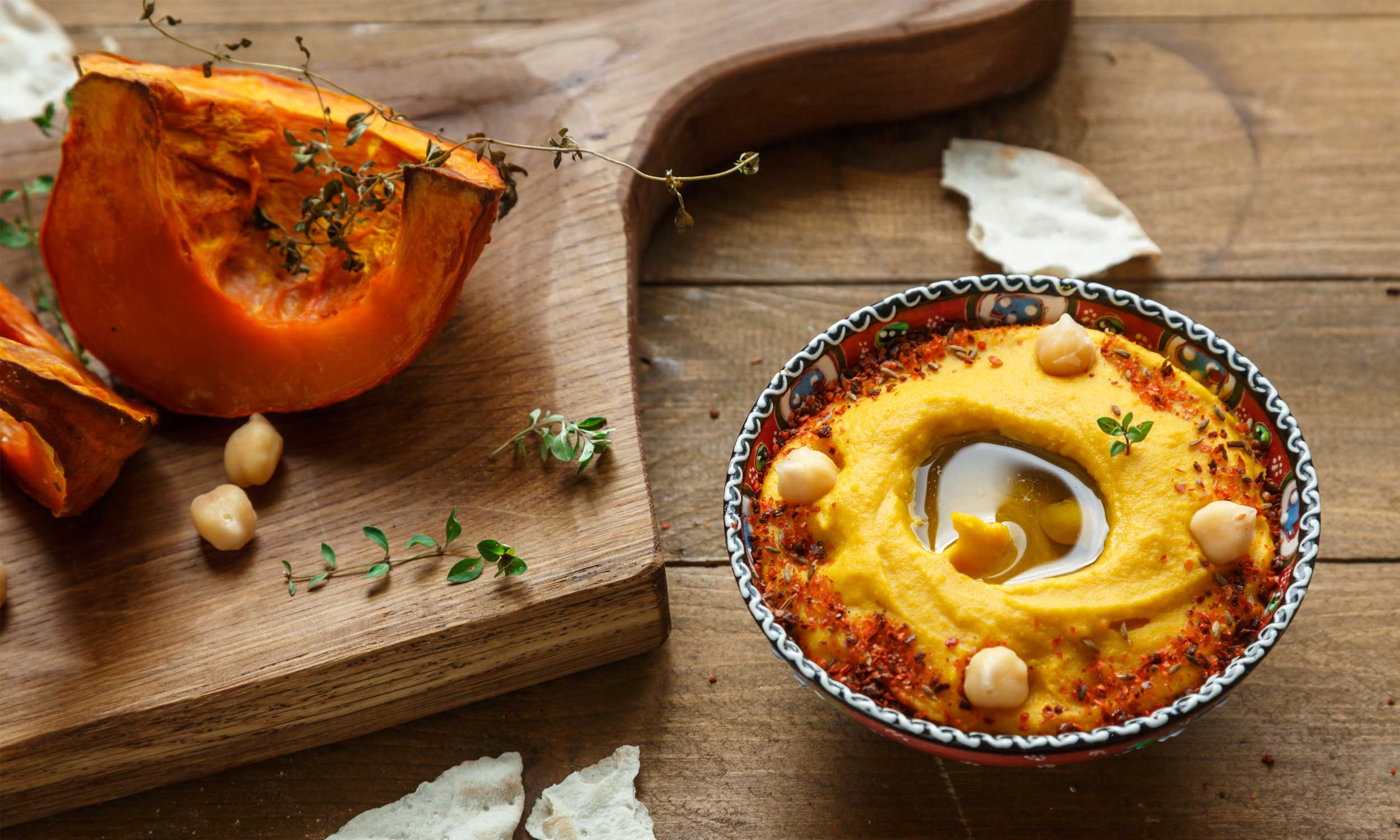Did you know that we publish a recipe almost every month? It is now more than 25 recipes that you will find on the Vitoli blog in the “Recipes” tab. This month we have a special request: a hummus recipe.
For countless health reasons, including cellular aging; consuming more vegetable protein would be a key to longevity. Replacing animal protein with plant protein, in whole or in part, would be correlated with longevity and reduced risk of cardiovascular disease. To do this, you need something particularly tasty that will make you want to eat it again and again!
For this purpose, hummus is perfect for you; it contains chickpeas, which like any legume, is high in protein. The “Tahini” also known as sesame paste provides a considerable contribution of methionine; one of the eight essential amino acids. Sesame is also a fiber-rich food, and its fat is mostly monounsaturated.
We decided to add a rich dose of beta-carotene and zeaxanthin with the use of squash. All you need is a variety of veggies for dipping, crackers or pieces of whole-grain bread. Before offering you our little golden jewel, we would like to share its story with you.
Chickpea cultivation began 9,900 years ago. The first mentions of hummus date back from the 8th century BC in Mesopotamia, now mostly Iraq. The modern form of this delicious mash would have appeared in the Ottoman Empire during the 15th century. Eight candidates were fighting to find out their true country of origin. Among them, Lebanon, Israel and Palestine were the most active on this subject; they were closely followed by Greece, Turkey, Jordan, Syria and Egypt. We can say from the outset that each of these respective countries includes chickpeas, in several forms, in their gastronomy.
We’re confident our Roasted Squash Hummus will be more than just a vegetable dip; it will also be the best condiment to add to your sandwiches. In short, you will not be able to help but integrate it into your eating habits!
Roasted Squash Hummus
Ingredients
– 3 cups of roasted and cooled orange-fleshed squash
(Butternut (musky), Buttercup (Kabocha) or Hubbard)
*about a medium squash
– 1 can (about 2 cups) of chickpeas, rinsed and drained
– 7-8 fresh sage leaves
(Or)
– 1 to 2 sprigs of rosemary cut in half
– 6 roasted cloves of garlic
– 1 teaspoon of cumin and coriander seeds
(Dry roasted)
– Salt and pepper to taste
– 1 cup of sesame paste (Tahini)
– ½ cup of olive oil
– ½ cup of fresh lemon juice + water as needed
– Freshly chopped parsley to taste
– Food Processor
*Dark stainless steel baking tray
*Parchment paper
Steps
- We advise you to have the pumpkin puree ready and well cooled otherwise go to the second step, in which I will explain how to proceed. Thereafter, we will move on to the third step for making the hummus.
- Preheat your oven to 375 degrees Fahrenheit. Meanwhile, cover the surface of your baking sheet with a piece of parchment paper. Cut your medium squash in half using a large, fairly sharp knife, as this vegetable is quite firm. Reserve six cloves of garlic, as well as your chosen fresh herbs, either sage or rosemary depending on your choice. You will place three cloves of garlic and half of the herbs on each of your squash halves. Take care to pierce the skin of the squash with a fork or the tip of a knife, this will help with cooking. Now bake these golden beauties for 30 to 45 minutes.
- Once your Cucurbitaceous is cooked, using a tablespoon, you will scrape the flesh against the skin of the vegetable. In a plastic container, let the roasted garlic flesh and cloves cool. In a small skillet, roast the spices (cumin and coriander) over medium heat, until fragrant. This operation can take 4-5 minutes at most. Once roasted, transfer them to a small glass dish to temper them quickly. In principle, the flesh of your pumpkin will be ready to use, then you can move on to the next step.
- In your food processor, put all the ingredients in the container: the squash and its herbs, the chickpeas, the spices, the tahini, the olive oil, the fresh lemon juice, salt and pepper to taste. Pulse the mixture on low speed, until everything is homogeneous. If you find that the mixture is a little too thick, add water little by little, pulsing, so as to have the desired consistency. Transfer your hummus into serving dishes with lids, with which you can refrigerate them. Sprinkle hummus dishes with freshly chopped parsley if desired. You are now able to wow your guests at a party, or revamp your favorite sandwich, even a tomato one! Have a great summer and Bon Appetit everyone!
References:
- Huang J, Liao LM, Weinstein SJ, Sinha R, Graubard BI, Albanes D. Association Between Plant and Animal Protein Intake and Overall and Cause-Specific Mortality. JAMA Intern Med. 2020 Sep 1;180(9):1173-1184.
- Song M, Fung TT, Hu FB, Willett WC, Longo VD, Chan AT, Giovannucci EL. Association of Animal and Plant Protein Intake with All-Cause and Cause-Specific Mortality. JAMA Intern Med. 2016 Oct 1;176(10):1453-1463.
- Naghshi S, Sadeghi O, Willett WC, Esmaillzadeh A. Dietary intake of total, animal, and plant proteins and risk of all cause, cardiovascular, and cancer mortality: systematic review and dose-response meta-analysis of prospective cohort studies. 2020 Jul 22;370:m2412.






